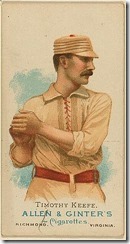 Generally speaking baseball has evolved through three different periods on pitcher usage, centering around starting pitchers.
Generally speaking baseball has evolved through three different periods on pitcher usage, centering around starting pitchers.
Prior to 1900, starting pitchers usually pitched with one or two games rest, e.g. Hoss Radbourn, Pud Galvin, Tim Keefe and other 19th century greats.
From around 1900 to the early ‘60s, starters worked mostly with three games rest.
Starting around the early ‘60s, the onset of relievers began and has since evolved to the extensive use of relievers that are categorized into long, middle, set-up and closer categories.
Detailed information on starts, games appeared, etc. are easily available on baseball-reference.com and the myriad of baseball encyclopedias that have been published.
I generally adhere to limiting starting pitchers to their actual number of starts (varying possibly by a start or two to make up for starters who were not issued cards) and the same for relievers.
You may have to use your imagination for teams that precede baseball in the 21st century. That’s because starters sometimes relieved. As a general rule, I try and limit the games appeared, starts, and relief appearances to their actual number in real life (or, if not a full-season replay, a pro-rated number of appearances).
Next: How to keep track of pitcher usage




“Prior to 1900, starting pitchers usually pitched with one or two games rest, e.g. Hoss Radbourn, Pud Galvin, Tim Keefe and other 19th century greats.”
Or less! In 1883 Pud Galvin started 75 oh hs teams 97 games. He started three out of every four games! Not much rest there.
Sorry for the bad typing. I meant to say he started 75 OF HIS teams games.